Westminster Council has opened a cycling consultation, linked to its cycling strategy. I’ve previously criticised the Strategy, which hasn’t changed that much since. (They have found some nice bicycle bullet points).
If you ever need to ride in Westminster, please respond to the consultation. Both by completing the survey, but also by emailing specific comments to cycling@westminster.gov.uk. Look also at the draft Central London Cycle Grid, which represents a first attempt to define the core cycle network in Westminster. If you work in the borough, you might want to try and get your employer and/or trade union to respond on behalf of staff. Some of the key critical points I think should be made are:
– Westminster needs to start seeing cycling as a solution, not a problem. Westminster’s problem is the continued prioritisation of private motor traffic.
– Getting the core network right is the priority here, given the currently poor provision.
– We need a commitment to the core network (at least) meeting the new TfL standards, defined in terms of coherence, directness, comfort, safety, attractiveness and adaptability.
– Westminster needs to move away from ‘Cycling Last’. Cycling is not something to facilitate only ‘where feasible’.
– The delivery of ‘quick wins’ needs to be accelerated.
– We need to know how Westminster will measure the extent to which it becomes a ‘national leader’ in cycling provision.
There are positive things in the document; for example, the policy on cycle parking. However, in the Westminster context, getting the routes right is top priority, and that’s what I focus on here. (The plans to improve Westminster’s cycling webpages wouldn’t be a bad thing, for example, but I hope colleagues in Hackney won’t be offended if I say I don’t really think it’s their website that has made Hackney a leader for cycling in London).
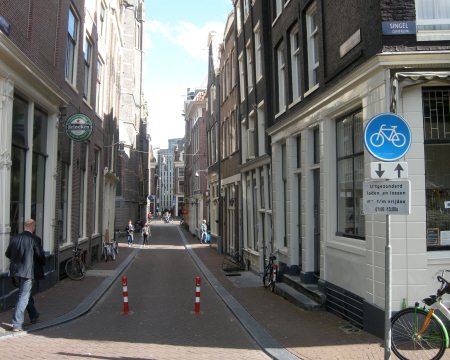
Here’s ‘narrow and historic’, yet somehow there’s space for cycling. Picture courtesy of As Easy As Riding A Bike.
In the strategy, there’s still great emphasis on Westminster’s ‘special circumstances’, which supposedly mean it just isn’t possible to better support cycling. But so many places could plead ‘special circumstances’. Amsterdam manages to provide for cyclists pretty well despite multiple challenges: including a plethora of very narrow streets, tramways, and drunk British men falling off the pavement in search of a brothel. By contrast, even Westminster’s not quite so special. Yet the Council merely seeks to ‘create a Central London Cycling Grid of well-signposted, direct and continuous cycle routes, where this is practical‘. Its consultation leaflet stresses that supporting cycling,
‘in a complex city like Westminster, with the physical constraints posed by many narrow streets, and our responsibility to keep the city moving and balance the needs of all road users is no easy task. We need to further improve things for cyclists without making it harder for other road users to get around the city or causing unacceptable increases in congestion.’
These weasel words (and really, “further” improve things for cyclists? How bad was it, before?) really aren’t congruent with the (admirable) high level aim near the start of the Strategy to ‘make Westminster a national leader in cycling provision’, or with Westminster’s target of 7% of journeys by bike, by 2026.
7% mode share by 2026 is an ambitious target, and I’m glad the Council has revised it upwards from the previous version of the Cycling Strategy. Westminster’s currently at 3%, while Hackney, with the highest cycle mode share in London, is currently at 6%. So Westminster, within 13 years, has to become more cycle-friendly than Hackney is now. It’s possible – and would be fantastic – but it needs resolution, not excuses.
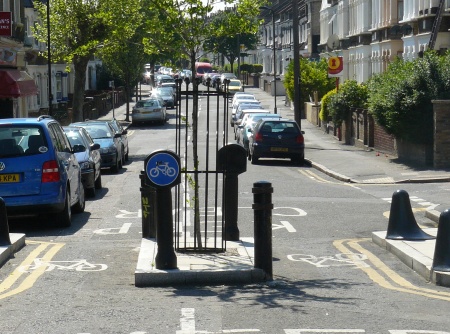
Modal filter, Hackney. Pedestrians benefited, as the scheme meant car parking could be moved off the pavement; residents benefited from the former rat run in front of their homes becoming safe and sociable space.
Hackney’s parks generally allow considerate cycling anywhere, for example, providing many safe, motor-traffic free routes. In Westminster, many parks are run by the traditionally anti-cycling Royal Parks. I hope Westminster will help Boris lean on the Royal Parks, but in the short to medium term parks in Westminster aren’t going to be as cycle-friendly as in Hackney.
This makes it even more important that (a) there’s a dense network of on-road cycle routes and (b) those routes really are good, as separate from motor traffic as possible. This needs to be done through reducing the volumes and speeds of motor traffic with which cycles must share space. Depending on the function and the nature of the road this can be done, for example, via modal filtering, as in many Hackney streets, or on busier roads through segregation. Luckily, Westminster has lots of main roads with space for cycle tracks, and lots of narrow historic streets that would be much more pleasant without through motor traffic.
But rather than seizing this opportunity to transform Westminster, the strategy apologises in advance by stressing the other demands on street space – private cars, taxis, loading, coaches, pedestrians, buses – which apparently mean that there just isn’t space for cycling. Talking on page 25 about the Cycle Grid (remember: core cycle routes in the borough), the strategy says that some Grid streets won’t need any interventions, except signing, if they’re ‘already two-way and the street is considered to be sufficiently quiet and safe for novice cyclists.’ Fair enough – the London Cycling Campaign sets 2,000 Passenger Car Units per day as this limit; TfL and Sustrans are currently coming up with some similar guidance. But most streets on the proposed Grid are likely to be busier than this. And here’s the rub.
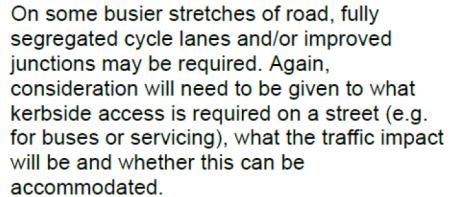
Sorry cyclists, you may require safe space and junctions on your core networks, but other demands may come first (again).
Some roads on the nominated cycle network are currently far too busy for pleasant and safe cycling. Westminster acknowledges this. (It’s a pan-London problem). Yet, where this is the case, Westminster here stress that safe space for cyclists on the core cycle network is dependent on it not causing too many problems for any kerbside use or for motor traffic flow. This is the ‘cycling last’ mindset that has made so many of Westminster’s roads so hostile, including much of the London Cycle Network as it passes through the borough.
I think people need to respond making it clear that cycling is not an additional problem for Westminster. It’s part of the solution – and can make things better for pedestrians, shops, residents, visitors etc. too. But Westminster needs to stop prioritising through motor traffic and unnecessary car trips. A borough stuffed full of fuming motor vehicles isn’t just hostile to cycling. It becomes an unpleasant and unsafe place to walk, live, work and shop.
Westminster’s own Transport Policy 15 (Traffic Reduction) argues this point:
To minimise the adverse effects of traffic on the environment and amenity, the City Council will seek to increase the use, integration and development of public transport, cycling and walking as viable alternatives to motor vehicles and reduce the use of private motor vehicles, particularly, but not exclusively, through and commuter traffic.
This approach – were Westminster seriously to implement it – would be in line with local social trends suggesting substantial suppressed demand for cycling. Two-thirds of Westminster households don’t own a car. While the number of households resident in Westminster increased by 16% between 2001-11, the total number of cars or vans owned actually declined. In this context, the failure to grow cycling significantly between 2001-11 is shocking. Car availability declining, motor vehicle speeds declining – scarcely over 10mph in the morning peak – and yet, as the Strategy points out, ‘Cycling currently represents just 3% of trips’ for Westminster residents. How has Westminster managed to get it so wrong? There’s slower, more congested roads at peak times, public transport’s often stretched to capacity, car ownership’s low and declining … and yet, cycling is far from a mode of choice.
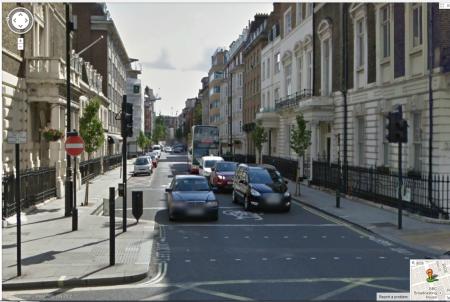
Sorry cyclists, it just wasn’t feasible to give you a pleasant, safe, and direct route here. This is actually one of the nicer stretches of New Cavendish Street, a key East-West cycle route in Westminster. One-way with no cycle exemption, too.
The repeated talk of ‘minimising congestion’ ahead of cycle provision is risible when placed against the 10mph morning peak speeds for motor traffic. New Cavendish Street is a current London Cycle Network Route. It’s on my route to work, and is the part of my commute where I most often experience near misses, because of the poor provision for cycling and generally bad road design. It’s one way – with no exemption for cyclists – and consists of two wide lanes of one-way motor vehicle traffic with car parking on one and often both sides.
It’s not working for anyone. For cyclists, it’s an insult, not a route. Pedestrians have to dash across junctions where there is often no dedicated pedestrian phase, and struggle with narrow pavements. It’s not even working for people in a motor vehicle, in whose interests the street and junction layouts are designed. During the rush hour motor traffic slows to a crawl. This obstructs emergency vehicles and essential deliveries, as well as cyclists.
Bond Street, another ‘London Cycle Network’ route is similar. And one of the promising aspects of the draft Westminster Cycle Grid is the proposal to put Bond Street on the ‘Jubilee Line’ for cycling. Currently, it’s disfigured by the apparently over-riding necessity – as elsewhere in Westminster – to cram in up to four one-way lanes of moving or parked motor traffic. It doesn’t create a pleasant shopping environment in this historic upmarket location. Putting in proper space for cycling here – like closing Glyn Road to through motor traffic – could help reclaim the street for people. At the moment, it’s just another part of London’s heritage that looks like a car park (off-peak) or a racetrack (on-peak).
Yet despite these conditions, despite Westminster’s suppression of cycling, some of us still persist and there are large cycle flows into the borough. Westminster has a responsibility to provide safely for these, at the same time as ensuring a substantial increase in cycling. The Cycle Census showed us that cycles make up nearly 30% of all road traffic heading Westbound on New Cavendish Street in the morning peak. And yet, cyclists are squeezed between 3-4 lanes of parked or moving motor traffic (including 500 motor vehicles passing per hour during the morning peak).
Of great concern to me in the Strategy is the lack of reference to the forthcoming updated London Cycle Design Standards, and to aligning the routes delivered in Westminster to the Level of Service to be specified there. Instead, the Strategy merely promises that ‘Cycle routes will be, as far as is possible, direct, legible, coherent, attractive and comfortable to use.’ This isn’t good enough. This is the core cycle grid. It’s not an add-on, a nice-to-have for cycling, like valet parking with free maintenance checks and massages for tired riders. This is the basics. We can see the likely result of failing to get this right, in what Danny Williams has called the ‘Drunken Spider‘ approach taken in parts of the draft Westminster Cycle Grid.
It simply is not acceptable to have one way routes within a core cycle network. I accept that there may be some roads in Westminster that remain one-way for cycling, even though it’s not best practice and creates unnecessary additional delays. But I do not accept that any authority seeking to be a ‘national leader’ would plan for any roads within the core network to be one-way for cycling. These routes should be routes that prioritise cycling; providing exemplary directness, legibility, coherence, attractiveness, comfort and safety. If Westminster is to be a national leader, these routes cannot be fit for purpose only ‘where feasible’. They have to be good – no, excellent – all the time.
As well as high quality, flagship infrastructure on those busy Grid roads, we need ‘quick wins’ to be pursued much more decisively. Case Study One at the start of the Strategy Appendix refers to Hanover Street, where a contraflow and crossing improvements were implemented. These kinds of simple permeability improvements should be fast-tracked and rolled out across the whole network, which currently is disfigured by complex one-way and no-turn systems that usually apply to bicycles as well as motor vehicles. (There are nearly 2,000 ‘prescribed routes’ in Westminster! Prescribed routes include those with banned or compulsory turns; one-way streets; no entry points and restrictions on vehicular access.)
Again, acting more decisively is in line with Westminster’s existing Transport Policy 9: Cycling, which states that Westminster will (A2):
normally allow cyclists to turn at junctions and enter streets where certain movements by motor vehicles are banned as part of a traffic management or environmental scheme, where safety issues permit.
I wonder what proportion of Westminster’s prescribed routes are currently cycle-permeable, and what the target might be here? We need some way of measuring whether Westminster has progressed towards its goal of being a ‘national leader’. There are different ways this could be done. All designated cycle routes could be audited against TfL’s Level of Service criteria in the forthcoming London Cycle Design Standards. Or, the entire potential network of routes for cyclists (including park links) could be assessed in relation to key volume and speed criteria, such as those developed by the London Cycling Campaign. What proportion of this network allows cyclists to ride in both directions without having to mix with fast or busy motor traffic (or dismount and walk)?
Finally, a hopeful sign. The cycle parking strategy suggests that under-used residents’ bays might be converted to cycle parking (something I’d strongly support; but also, why not aim to convert under-used bays to cycle contraflows or tracks where appropriate?). The number of residents’ car parking permits has declined by 28% in four years, a demand Westminster envisages will continue. Occupancy rates for residents’ bays ranges from 62% to 79%. With declining demand for car parking, and the use of cars to commute falling, converting some of the surplus car parking space to space for cycling is increasingly likely to be popular. Another way in which cycling really should be seen as a solution by Westminster politicians.


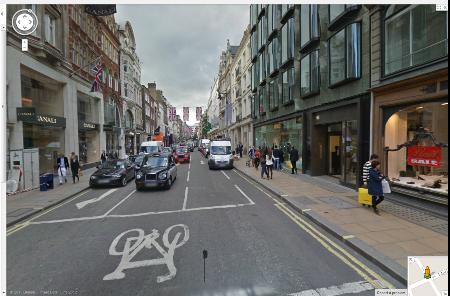
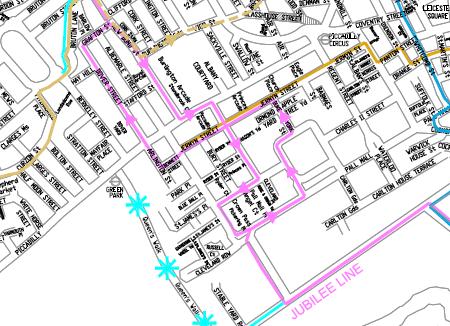
You have identified the setbacks to progress that will continue around the regions for years. Well done. Re-framing Active Travel as a solution not part of the problem is whats needed, for as the years of prioritising vehicular transport have led to obesity, congestion and travel generally at breaking point- only Active Travel, walking, cycling, fast public transport can reverse this.
As London leads so Regions follow, when the language of Departments in London changes backed with action so will Local Authorities- following as they always do.
I just went through the Westminster survey. It is truly remarkable. Westminster appear to think that the problem that they face is one which can be solved simply by saying enough words to people. Training, consulting, suggesting etc. appear to be all the options that they’re offering when this problem cannot be overcome that easily because people are scared witless and won’t cycle for that reason.
They clearly have no idea how to do this.
I’m surprised by your treatment of Westminster with kid gloves. 7% cycling mode share by 2026 isn’t “admirable”, it’s just a fob-off never-never target that is totally meaningless and toothless.
2/3 of Westminster residents don’t own cars. That’s more than a Super-majority in US political-speak. I suggest a takeover of Council by the majority i.e. democracy, is the only practical solution to improve cycling infrastructure in this fiefdom.
Good analyses of the strategy. Enjoyed reading this.
I have sent in these comments to cycling@westminster.
Having completed your survey I have some additional comments. I have been resident in Westminster (London SW1V) since 1993 and like the majority of Westminster residents I do not own a car. I do own a bicycle.
There is an urgent need for better cycle routes within and through central London. While the proposed cycling grid and related improvements are welcome in principle I do not think they go far enough. In particular
a) a much bolder approach is needed, learning from best practice in Amsterdam, Vienna and other European cities. The current strategy is too deferential to the interests of motorised road users (‘we’ll take action provided it does not disturb motor traffic flow’). In some areas, including a workable cycling grid, it should be a case of putting cyclists first. This may require closure of some streets to motor traffic and rerouting the motor traffic elsewhere, and/or the greater adaptation of pavements for cyclist and pedestrian use. There are plenty of examples in Europe, for example Vienna and Amsterdam, with similar legacies of old cities and narrow streets.
The current draft strategy reads (4.1 A)
Cycle routes will be, as far as is possible,direct, legible, coherent, attractive and comfortable to use. Segregated cycle lanes will be considered as part of this process.
A bolder approach is needed along these lines
‘Cycle routes will normally be segregated from motor traffic, direct, legible, coherent, attractive and comfortable to use. To achieve this greater use will be made of dedicated and continuous cycle lanes, street closure to motor traffic and/or through motor traffic and to extension of pavements to provide separate space for use by cyclists and pedestrians.
b) I recently cycled along so called cycle routes following the broad direction of the Circle Line. The cycle paths were often narrow and with dangerous discontinuities where cyclists had to merge with motor traffic. I found this hazardous enough on a Sunday and the thought of cycling much of it on a weekday is very off putting. The new grid is needed very soon and needs to be properly segregated from other traffic.
c) Cyclists need easier access to the mainline rail stations. Access to Waterloo can benefit from the cycling superhighway for a part of the journey but access from my area SW1V to Euston or Kings Cross is currently complicated and hazardous.
d) Tube services in and out of London need better facilities and better access for cyclists. Euston and Kings Cross underground are currently ‘no go’ areas for cyclists and this needs to change. The ongoing refurbishment of Victoria station needs to include better facilities for getting cycles onto the underground platform.
e) There are cycle routes following the river but again there are discontinuities. What is needed is a continuous route along the river from Richmond to Tower Bridge and beyond. The river provides a healthier environment for cycling as the open space allows greater dilution of traffic pollution which cyclist are forced to breathe.
f) The Royal Parks provide a good environment for cyclists and the strategy makes a welcome provision to improve access from surrounding roads. One area where improved access is needed is in the vicinity of Buckingham Palace. However many routes are barred and there is no cycle path in for example St James Park. More space for cyclists in the royal parks should be included in the strategy.
Finally I am grateful for this opportunity to comments and hope that you will be able to improve the strategy in the ways suggested.
I have submitted a proposal to TFL under the consultations for the GRID, to provide a dual lane cycle route along the back of Buckingham Palace Gardens to link hyde park corner to victoria station – currently your choice is the death trap of Grovesnor Place or the meander through the back streets. There is plenty of room becuase noone walks along that part of the pavement as being a high security area, there is nothing to go there for. Now Ive seen your blog Ill send it to Westminster direct.